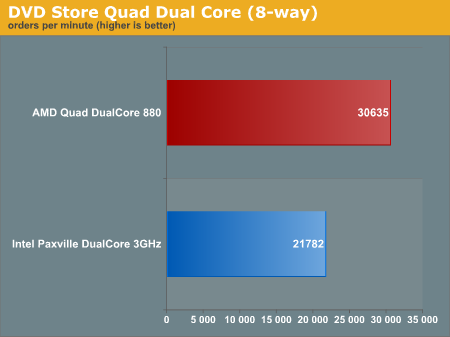Eight Core Servers: Opteron 880 (Egypt) vs. Xeon MP 3.0 GHz (Paxville)
by Jason Clark on April 24, 2006 2:00 AM EST- Posted in
- IT Computing
Dell DVD Store
The Dell DVD store test is a new addition to our test suite, and essentially replaced our old order-entry test.

Here the Opteron leads by 41%. This test is indicative of an enterprise level e-commerce application.
Conclusion
At present, Opteron has a commanding lead in 8-way configurations. Looking at the prices of the processors we used, AMD has the advantage there as well. The Xeon MP 3.0 GHz processors currently cost upwards of $3000 each, whereas Opteron 880 are about $1000 less. Of course, for enterprise servers price is less of a concern; performance, scalability, and reliability take precedence. Reliability might be a tie, but that's about as close as Intel's Xeon MP currently comes to Opteron.
Nothing that we've written in this article should be a surprise. All of our Opteron benchmarks have shown the scalability of the K8 architecture. The elusive question is, what next? AMD is completely quiet about anything other than a socket and memory controller change; is that enough to fend off Woodcrest? We speculate that the end of the year will be interesting to say the least. What we've seen of initial Bensley performance looks promising, and the Woodcrest addition later on should kick the competition up another notch. If everything goes as planned, Intel may just regain lost ground.
The Dell DVD store test is a new addition to our test suite, and essentially replaced our old order-entry test.

Here the Opteron leads by 41%. This test is indicative of an enterprise level e-commerce application.
Conclusion
At present, Opteron has a commanding lead in 8-way configurations. Looking at the prices of the processors we used, AMD has the advantage there as well. The Xeon MP 3.0 GHz processors currently cost upwards of $3000 each, whereas Opteron 880 are about $1000 less. Of course, for enterprise servers price is less of a concern; performance, scalability, and reliability take precedence. Reliability might be a tie, but that's about as close as Intel's Xeon MP currently comes to Opteron.
Nothing that we've written in this article should be a surprise. All of our Opteron benchmarks have shown the scalability of the K8 architecture. The elusive question is, what next? AMD is completely quiet about anything other than a socket and memory controller change; is that enough to fend off Woodcrest? We speculate that the end of the year will be interesting to say the least. What we've seen of initial Bensley performance looks promising, and the Woodcrest addition later on should kick the competition up another notch. If everything goes as planned, Intel may just regain lost ground.










35 Comments
View All Comments
Ganjalf - Monday, April 24, 2006 - link
You're correct! The Opteron has a 36-51% lead over the Paxville.Theunis - Monday, April 24, 2006 - link
What about power consumption and heat dissipation? More heat would require more power for air conditioners? More power to the server room requires, the more money you have to spend to maintain the solution.Jason Clark - Tuesday, April 25, 2006 - link
How about a separate article, short but go through powernow and the numbers?Cheers
Jason Clark - Monday, April 24, 2006 - link
We wanted to do power consumption numbers, however the Opteron was a 110V system and the Paxville is a 220V system :)...Cheers
Ecmaster76 - Monday, April 24, 2006 - link
Err, you can measure power on a 220V system too. Its not that hard and the numbers will certainly be comparable.AnandThenMan - Monday, April 24, 2006 - link
What difference does that make exactly? Wattage is wattage. The supply voltage has no effect on total system power draw. Perhaps the Intel box draws too much power for the measuring equipment to handle. ;>)
mino - Monday, April 24, 2006 - link
It MAKES adifference of around 3-5% in favor of the 220V system(whatever system it is)The same efficiency PSU is generally 3-5% more efficient than 110V one. To convert from 220 to 12V is simply "easier" than to go from 110V. This is also the reason 12V rail is employed for powering CPU's and GPU's PWMs. It is simply more efficient.
However the power comparison would not hurt since Dempsey would be used in real system so the Intel system handicap would be offset somehow.
Seems K8L is gona come right on time for Core MP chips...
Lifted - Monday, April 24, 2006 - link
Agreed, doesn't make a difference since a co-lo is giving you an certain Amp circuit with your rack, regardless of the voltage you need, and will charge you more per Amp required.xtremejack - Monday, April 24, 2006 - link
Didnt paxville come out in Q4 last year, why this review now? We all know Paxville was just a stop-the-bleed solution by Intel, to get a Dual-Core Xeon. It was never expected to be a performance part at all. So why this no-brainer review? The market's moved on. A point in Paxville's favour is its virtualization support though.DrMrLordX - Monday, April 24, 2006 - link
Even worse, Paxville is an older chip than Dempsey. I have to wonder if Intel's best MP offering is a 3 ghz Paxville chip. Is this true? If so, why? Intel has released 3.6 ghz Dempsey-based Xeons have they not? Dempsey and Paxville aren't too far off from one another, but if I recall correctly, Paxville was based off Smithfield while Dempsey was based off Presler (making Dempsey superior to Paxville).If Intel can't ship anything better than a 3 ghz Paxville in 4-way configurations, it's no wonder that they're losing. AMD has also released the Opteron 885, meaning the benchmarks we just saw were not run using AMD's best 4-way/8-way chip!